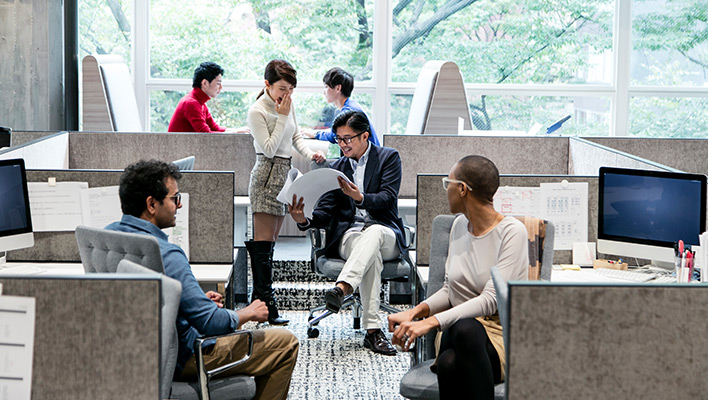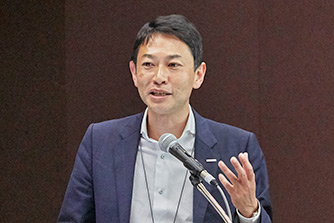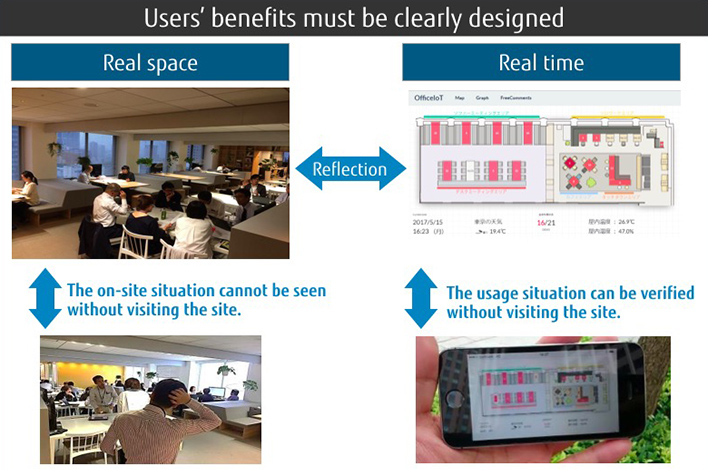
Accelerating Work Style Innovation
by Visualizing
Work Style Habits
with Space IoT
"I will talk about three points regarding using IoT to accelerate work style innovation: first, the work style issues that can be observed in offices today; second, the IoT requirements necessary to accelerate work style innovation; and third, expectations for IoT from the viewpoint of work style innovation.
"Examining offices makes work style issues obvious. I recommend that you review the potential issues in your office. What we call 'work style habits' can be observed there. For example, there are work style habits inherent in your company and office culture. If you are not aware of the need to clarify and change such habits, work style innovation will not progress.

Kenichi Suzuki
General Manager,
Work Style Innovation Group,
Space Solutions Department,
Furniture Business Division,
KOKUYO Co., Ltd.
"Based on these basic ideas, people tend to immediately start examining and working on how to achieve the desirable office as well as finding what kinds of tools are required; however, these are matters of 'How.' Instead, you should first work on 'Why' you will innovate work styles and 'What' you expect from the innovation. Only after working on 'Why' and 'What' can you properly work on 'How.' This process is very important."
Kokuyo's Space IoT Consulting for Visualizing Work Style Habits
"Second, I will talk about the IoT requirements necessary to accelerate work style innovation. Many solutions for connecting things with services have appeared on the market. Kokuyo has also conducted various experiments since 2008. As a result, we have identified the following important requirements: user benefits must be clearly designed; data must be able to be accurately obtained (regardless of whether or not employees (users) wear IoT devices); IoT devices must have long service lives that do not cause users to worry; and the solution must be as simple as possible.
"When considering the work style habits I mentioned earlier, for example, sometimes a meeting held after 7 p.m. takes as long as two or three hours, although the same meeting would take only an hour if held early in the morning. In the 'space IoT consulting' provided by Kokuyo, the office usage situation is monitored by a sensor according to the office's characteristics to measure workspace activities. Since the sensor operates 24/7, everything is visualized, including space usage during early morning work and overtime hours. This enables users to identify the elements of the organization's culture that cause overtime work. Thanks to the idea of 'space IoT,' which changes a company's existing space into an IoT space, issues that have gone unnoticed can be visualized as concrete improvement targets.
"For example, by identifying busy periods, users can reschedule conferences and meetings that have become concentrated in the morning to the afternoon. If a space is frequently used for meetings, it can be expanded or the number of meeting rooms can be increased.
"In this way, the greatest advantage of 'space IoT consulting' is that it helps users to visualize the characteristics of the company's culture and activities as well as to uncover issues and further implement improvement measures by looking ahead in accordance with the company's current work style.
"As for consulting, Fujitsu provides devices and systems that are highly precise, of great quality, and that offer excellent maintainability based on its technical, solution, and procurement capabilities, while Kokuyo provides unique ideas, definitions of space and activities, and our long-accumulated know-how to ensure stable acquisition, aggregation, and analysis of data."
An experiment at Kokuyo's Kasumigaseki office

Expectations for Work Style Innovation Using IoT
"Third, I will talk about expectations for IoT. If the benefits for management as well as for employees are not set, the IoT strategy will not lead to actual implementation or continuous measurement and application thereafter. When implementing IoT for employees, if it is brought into a work site unilaterally from the management's perspective, employees tend to feel they are being forced into doing it. Thus, it is important to carefully design employee benefits.
"Kokuyo helps to promote innovation with 'work styles' as the key. However, focusing only on 'work' does not lead to substantial innovation. Broader perspectives must be incorporated into innovation that cover not only 'work' but also 'life' as well as 'learning and growth' through work and life.
"Regarding the prospects, in order to respond to each company's requirements to further accelerate work style innovation, we will develop solutions that cover the fields of telework (*), WELL-BEING (**), and Activity Based Working (***) through co-creation based on the Human Centric concept advocated by Fujitsu.
"If work style innovation is promoted based on the idea of 'Vitalizing Japanese Society through Work Style Innovation,' I believe all of Japan will vigorously move in a good direction."
(*) A flexible work style that uses ICT to eliminate restrictions imposed by location and time (**) To increase corporate value through an environment that imposes a lesser burden both physically and mentally (***) A mechanism that enables workers to work from anywhere according to their tasks (activities) to achieve creative work results
Presenter

General Manager,
Work Style Innovation Group,
Space Solutions Department,
Furniture Business Division,
KOKUYO Co., Ltd.
